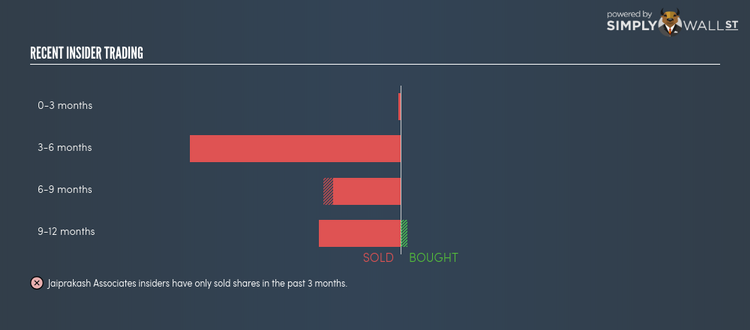Why Jaiprakash Associates Limited’s (NSE:JPASSOCIAT) Ownership Structure Is Important

In this article, I will take a quick look at Jaiprakash Associates Limited’s (NSEI:JPASSOCIAT) recent ownership structure – an unconventional investing subject, but an important one. Ownership structure has been found to have an impact on shareholder returns in both short- and long-term. Since the effect of an active institutional investor with a similar ownership as a passive pension-fund can be vastly different on a company’s corporate governance and accountability of shareholders, investors should take a closer look at JPASSOCIAT’s shareholder registry.
Check out our latest analysis for Jaiprakash Associates
Institutional Ownership
In JPASSOCIAT’s case, institutional ownership stands at 18.58%, significant enough to cause considerable price moves in the case of large institutional transactions, especially when there is a low level of public shares available on the market to trade. Although JPASSOCIAT has a high institutional ownership, such stock moves, in the short-term, are more commonly linked to a particular type of active institutional investors – hedge funds. For shareholders in JPASSOCIAT, sharp price movements may not be a major concern as active hedge funds hold a relatively small stake in the company. Although this doesn’t necessarily lead to high short-term volatility, we should dig deeper into JPASSOCIAT’s ownership structure to find how the remaining owner types can affect its investment profile.
Insider Ownership
I find insiders are another important group of stakeholders, who are directly involved in making key decisions related to the use of capital. In essence, insider ownership is more about the alignment of shareholders’ interests with the management. With a stake of 4.97%, insiders seem to have some alignment of interest with shareholders. A higher level of insider ownership has been found to reflect the choosing of projects with higher return on investments compared to lower returning projects for the sake of expansion. It would also be interesting to check what insiders have been doing with their shareholding recently. Insider buying can be a positive indicator of future performance, but a selling decision can be simply driven by personal financial requirements.
General Public Ownership
A substantial ownership of 39.59% in JPASSOCIAT is held by the general public. This size of ownership gives retail investors collective power in deciding on major policy decisions such as executive compensation, appointment of directors and acquisitions of businesses. This level of ownership gives retail investors the power to sway key policy decisions such as board composition, executive compensation, and potential acquisitions. This is a positive sign for an investor who wants to be involved in key decision-making of the company.
Private Company Ownership
Potential investors in JPASSOCIAT should also look at another important group of investors: private companies, with a stake of 35.54%, who are primarily invested because of strategic and capital gain interests. An ownership of this size indicates a strong financial backing and has the potential to influence JPASSOCIAT’s business strategy. Thus, investors should dig deeper into JPASSOCIAT’s business relations with these companies and how it can affect shareholder returns in the long-term.
Next Steps:
JPASSOCIAT’s considerably high level of institutional ownership calls for further analysis into its margin of safety. This is to avoid getting trapped in a sustained sell-off that is often observed in stocks with this level of institutional participation. However, if you are building an investment case for JPASSOCIAT, ownership structure alone should not dictate your decision to buy or sell the stock. Instead, you should be evaluating company-specific factors such as the intrinsic valuation, which is a key driver of Jaiprakash Associates’s share price. I highly recommend you to complete your research by taking a look at the following:
1. Financial Health: Is JPASSOCIAT’s operations financially sustainable? Balance sheets can be hard to analyze, which is why we’ve done it for you. Check out our financial health checks here.
2. Past Track Record: Has JPASSOCIAT been consistently performing well irrespective of the ups and downs in the market? Go into more detail in the past performance analysis and take a look at the free visual representations of JPASSOCIAT’s historicals for more clarity.
3. Other High-Performing Stocks: Are there other stocks that provide better prospects with proven track records? Explore our free list of these great stocks here.
NB: Figures in this article are calculated using data from the last twelve months, which refer to the 12-month period ending on the last date of the month the financial statement is dated. This may not be consistent with full year annual report figures.
To help readers see pass the short term volatility of the financial market, we aim to bring you a long-term focused research analysis purely driven by fundamental data. Note that our analysis does not factor in the latest price sensitive company announcements.
The author is an independent contributor and at the time of publication had no position in the stocks mentioned.


